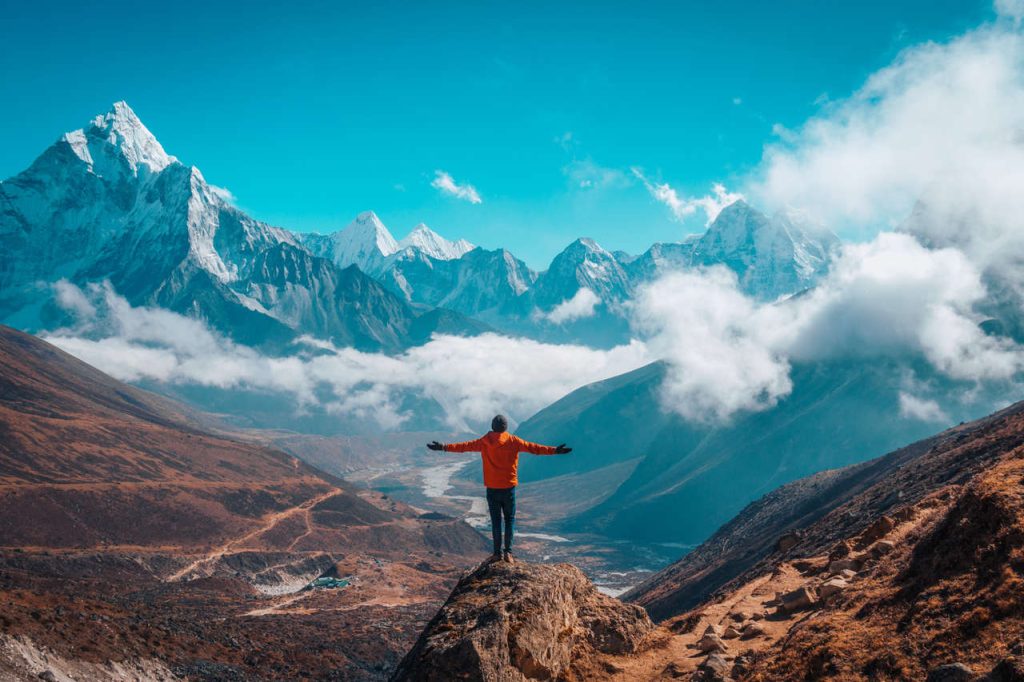Introduction
Every journey begins with a dream, and many people’s dreams include seeing the world’s highest mountain peak, Mt Everest (8,448.86m), from its base. Everest Base Camp, located at an elevation of 5,364 metres, is the ideal destination for adventure seekers willing to commit to a strenuous trek full of spectacular views and amazing hospitality from locals to visit the mountain museum- Everest region of Nepal.
The Everest Base Camp trek is a breathtaking high-altitude trek in Nepal’s mountains. Exploring the challenging trekking routes around the world’s highest mountain will provide you with breathtaking scenery and a one-of-a-kind cultural experience. You’ll realise it was a good decision when you see the scenery, which is breathtakingly beautiful and unlike any mountainous terrain you’ve ever seen before, changing from lush green farmland, dense forest, and glistening blue fast-flowing rivers to barren land and glacial pools as you climb. There’s a reason it’s called the “steps to heaven.”
Everest Base Camp Trek Highlights
- A dramatic and scenic 30-minute flight to the world’s most extreme airport, Luka Airport.
- A pleasant and lively walk along the Dudhkoshi River’s bank, passing through the renowned Sagarmatha National Park entrance and alpine forest.
- Investigate the Sherpa people’s culture and way of life.
- The splendour of the world’s highest peak, Mt. Everest (8,848.86m).
- Other peaks visible include Mt. Lhotse (8,516m), Cho Oyu (8,188m), and Mt. Makalu (8,485m)
- Investigate UNESCO World Heritage Sites.
- Prayer wheels, colourful flags, Mani stones, and high suspension bridges are all common sights.
- The diverse Flora and Fauna.
- Wildlife such as musk deer, colourful pheasants, snow leopards, and Himalayan Thar can be found here.
- Khumbu Glacier is the highest glacier on Earth (4,900 m)
- Kala Patthar offers an incredible panoramic view (5,545m)
How long does it take to reach the base camp of Mount Everest?
The trek to Everest Base Camp typically takes 12 days to complete on a 130km round-trip, but this depends on the trekker’s fitness level, weather, rest days, and so on. It takes eight days to reach Base Camp and four days to return, with nine days of long trekking and three days of short trekking acclimatisation.
Trekking Route to Everest Base Camp in Nepal. For EBC trekking, there is a set route that takes you through various villages, camping grounds, and incredibly isolated spots with breathtaking views of the mountain panoramas.
Way up:
Kathmandu-Lukla-Phakding-Namche Bazaar-Tengboche-Dingboche-Lobuche-Gorak Shep-Everest Base Camp
Normal Itinerary
Day 1: Flight from Kathmandu to Lukla. Phakding Village Trek
Day 2: Phakding to Namche Bazaar
Day 3: Acclimatization in Namche Bazaar (trek to Thame and Khumjung, the green village)
Day 4: Tengboche Trek from Namche Bazaar
Day 5: Tengboche to Dingboche
Day 6: Dingboche acclimatisation (hike to Chhukung or Nagarzhang Peak)
Day 7: Dingboche to Lobuche Village
Day 8: To get to Everest Base Camp and back to Gorak Shep, cross the Changri Glacier.
Day 9: Gorak Shep to Pheriche
Day 10: Pheriche to Tengboche
Day 11: Tengboche to Monjo village
Day 12: Spend the night in Lukla after traveling from Monjo. The following day, I flew back to Kathmandu.
Is the trek to Everest Base Camp difficult?
12 Weeks The Everest Base Camp Trek is both difficult and rewarding. To be successful on this physically demanding trip, some proactive planning is required. Exercising and jogging on a regular basis for a few weeks before the trip departure is a good idea to improve our stamina. The trek can be completed by novice trekkers with average fitness levels; however, the fitter we are, the more enjoyable the trek will be. Previous hiking experience would be advantageous, but no technical experience or skills are required. Participants must be able to hike 4 to 6 hours per day at a reasonable pace while carrying a light day pack.
The trekking route entails hiking along the rocky mountain, with steep ascents and descents. It is critical to ensure that you are as healthy as possible before beginning the trek. Participants who have pre-existing medical conditions such as heart, lung, or blood disease should notify us or consult with their doctor before booking the trek.
Ideal time to go to Everest Base Camp?
The weather in the Himalayas varies, and the best trekking seasons are typically determined by the arrival of the summer monsoon. Many hikers travel during the spring, which lasts from February to March, to avoid the wettest conditions. This is the time of year when wildflowers bloom and temperatures are at their lowest.


